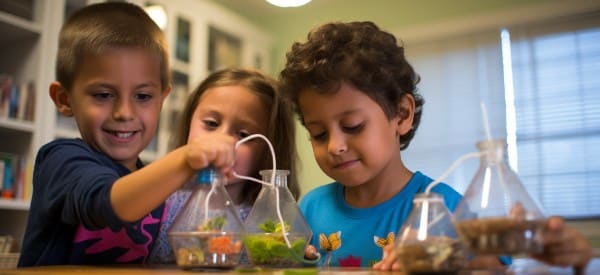I firmly believe that a parent is a child’s first teacher. Yet, when teaching STEM (Science, Technology, Engineering, and Math) to my son, I was petrified. Not because I doubted his learning capacity but because I thought it would require structured, almost ‘classroom-like’ lesson plans.
The thought of adding another task to my already overflowing plate was overwhelming. How was I supposed to squeeze in time to create structured lessons when there were lunches to pack, clothes to wash, and, oh, a full-time job to manage?
Then, one day while watching my son ask me questions about the sky and clouds, I realized that I could use everyday activities to help teach him about the world around him and have a little bit of fun at the same time. The activities we do every day – cooking, gardening, playing games – all have elements of STEM.
They’re just waiting to be discovered!
35 Examples Of STEM In Daily Life
As parents, we often stumble upon the same obstacle when it comes to how to teach STEM to my son. It’s not the lack of resources or time—it’s identifying the learning opportunities hidden in everyday activities.
Sounds familiar, right?
That’s why I’ve compiled a list of seven versatile activities corresponding to each aspect of STEM that you can engage with your little learners, and the best part is that these are activities that you likely already do throughout the day! I’ve included five conversation starters for each activity to help engage your child more deeply. Ready? Let’s dive in!
STEM Science For Kids

STEM science brings the world around us into focus. It nurtures kids’ curiosity and lays the foundation for understanding natural phenomena. Let’s look at ways you can show your kids how STEM science is used in everyday life today! daily stem
1. Kitchen Experiments
Use baking to explain chemical reactions, like how baking powder makes dough rise.
- Talk about how heat changes food (cooking eggs, baking bread) and why it happens (protein denaturation, yeast activation).
- Discuss the purpose of each ingredient in a recipe (flour for structure, baking powder for rise).
- Show how combining certain ingredients causes a reaction (baking soda and vinegar).
- Teach measurement and conversions, which are crucial in following a recipe.
- Explain food safety and why we preserve food (refrigeration, canning).
2. Plant Care
Teach botany by caring for houseplants or a home garden, explaining photosynthesis and plant growth cycles.
- Explain photosynthesis and how plants ‘eat’ using sunlight, water, and carbon dioxide.
- Discuss how different plants have different needs (sunlight, soil, water).
- Demonstrate how seeds grow into plants.
- Talk about the importance of pollination and the role of insects.
- Show how plants react to their environment (tropism), like turning towards the sun.
3. Weather Reports
Discuss daily weather changes and seasons, fostering an understanding of meteorology and climate science.
- Discuss what causes different types of weather (rain, snow, sunshine).
- Explain how weather changes with the seasons.
- Talk about how weather affects daily life and activities.
- Teach them to observe and predict weather patterns.
- Show how to use a weather app or website to understand weather forecasts.
4. Household Physics
Discuss the science behind everyday items, like how a light bulb works or why objects fall to the ground.
- Discuss gravity when objects fall.
- Talk about how light bulbs or LEDs emit light.
- Explain why some things are heavier than others (density).
- Discuss the physics of motion when playing with toys (force, friction).
- Show how magnets work and discuss magnetic fields.
5. Bath Time
Experiment with floating and sinking objects to teach concepts of buoyancy and density.
- Show how some objects float while others sink, explaining buoyancy and density.
- Demonstrate how water changes state (ice melting, boiling water).
- Discuss the concept of volume and capacity using bath toys or containers.
- Explain why soap forms bubbles (surface tension).
- Show how certain substances dissolve in water.
6. Shadow Play
Use sunlight or a lamp to create shadows, explaining the behavior of light and how shadows form.
- Explain how light travels and forms shadows.
- Discuss how the size and position of shadows change with the light source.
- Talk about opaque, transparent, and translucent objects.
- Show how colored objects can affect the color of the light.
- Discuss natural sources of light (sun, stars) and artificial ones (lamps, LEDs).
7. Mealtime Discussions
Please talk about the nutritional content of their meals, touching on biology and health science. Discuss their food journey, from farm to table, covering topics in agricultural science.
- Discuss where different foods come from (plant-based, animal-based).
- Talk about the journey from farm to table.
- Explain the importance of balanced nutrition and food groups.
- Discuss how cooking changes food, both in taste and nutrition.
- Talk about different dietary habits around the world.
From gardening to kitchen experiments, there are countless everyday activities to help your kiddos explore the wonders of STEM science. Keep that curiosity alive and thriving—every day presents a new opportunity to deepen their scientific understanding with STEM science projects and everyday activities. Happy experimenting!
STEM Technology For Kids
STEM technology involves understanding and applying digital tools, software, and modern tech to solve problems. It’s all around us! Teaching it to your children through everyday activities can stimulate their creativity and improve their digital literacy. Let’s check out some actionable and easy ways to show your child how STEM technology impacts them through everyday activities that you are likely already doing!
8. Digital Communication
Show your kids how to send emails or video calls to relatives, teaching them about internet communication.
- Discuss how video calls work and enable us to connect with people far away.
- Discuss internet safety rules when communicating online.
- Explain how attachments work in emails.
- Show how emojis and GIFs can be used to express feelings.
9. Online Research
Please encourage your children to look up information online for their school assignments or interests, demonstrating the use of search engines and reliable sources.
- Show how to use a search engine like Google to find information.
- Discuss the importance of choosing reliable sources online.
- Teach them how to bookmark useful websites for future reference.
- Show how online encyclopedias or educational sites can help with schoolwork.
- Explain how digital libraries work.
10. Online Learning Games
Utilize educational games and apps that teach STEAM subjects in a fun, interactive way.
- Explain how educational games combine fun and learning.
- Discuss how the challenges in these games enhance problem-solving skills.
- Talk about the importance of persistence when a game or level is challenging.
- Highlight how the interactive elements in the games teach different STEAM concepts.
- Discuss the role of technology in creating these interactive educational tools.
11. DIY Home Experiments
Conduct science experiments using household items and document the process digitally to practice data collection and analysis.
- Discuss how to form a hypothesis based on initial observations.
- Explain the process of conducting the experiment and collecting data.
- Discuss the importance of observation and how to document results.
- Talk about how to form conclusions based on the experiment’s outcome.
- Explain how scientists use similar methods in real-life research and discovery.
12. GPS Navigation
Please explain how the GPS on your phone works when you are driving or walking somewhere new, teaching them about satellites and mapping.
13. Using Home Appliances
Explain how different appliances work, such as a toaster (thermal energy) or a washing machine (mechanics and automation).
- Discuss the purpose of different home appliances and how they make our lives easier.
- Explain how electricity powers appliances to perform specific tasks.
- Talk about safety precautions when using electrical appliances.
- Discuss how various appliances work, like the heating element in a toaster or the motor in a blender.
- Explain how understanding these appliances’ workings can lead to innovations and improvements.
14. Smart Home Devices
Show them how voice assistants work and discuss the concept of artificial intelligence.
- Show how to interact with voice assistants like Siri or Alexa.
- Discuss how these devices use artificial intelligence to answer questions.
- Explain how smart devices connect to the internet.
- Show how to use voice commands to control other smart devices like lights.
- Discuss how intelligent devices can make our lives easier.
The wonderful world of STEM technology is as close as your next everyday activity. With these engaging tasks, your child’s tech knowledge can blossom. So, continue fostering their curiosity with technology activities for kids and watch as they master the magic of technology through these fun-filled adventures!
STEM Engineering For Kids

STEM engineering turns ideas into reality, focusing on designing, building, and improving things. As a parent, you can take everyday activities to support your child’s learning at home by adding an extra “layer” of education to everyday activities.
By exploring engineering at home, your child can develop problem-solving skills, boost creativity, and foster a strong analytical mindset. Let’s look at some everyday engineering activities that are fun and lay a strong foundation for your child’s future success.
15. Daily Drives
Talk to your child about velocity, speed, and acceleration as you drive around town. This is a great time to help them “feel” engineering and the forces they interact with daily.
- Discuss how the car’s engine works (basic principles).
- Please talk about the role of the car’s suspension system and how it works.
- Discuss how roads and bridges are engineered for safety and efficiency.
- Please talk about the principles of aerodynamics and how they affect a car’s design.
- Discuss the technology behind GPS navigation.
16. Cardboard Box Creations
Please encourage your child to create a structure or a playhouse from a cardboard box, enhancing their problem-solving and design skills.
- Discuss the importance of careful planning before construction.
- Explore the difference between stability in square versus round structures.
- Please talk about the weight and strength of the cardboard and its effects on the structure’s durability.
- Explore how to connect different pieces without using tape or glue.
- Discuss how architects and engineers use similar principles when designing buildings.
17. Bridge Building
Using popsicle sticks, toothpicks, and glue, challenge your child to build a bridge and test its strength with small weights.
- Discuss the different types of bridges (beam, arch, suspension) and their strengths.
- Talk about the importance of a strong foundation for stability.
- Discuss the concept of load and how weight distribution affects the bridge.
- Explain the concept of tension and compression in the structure of the bridge.
- Discuss real-world examples of bridge engineering.
18. Paper Airplanes
Teach your child to make paper airplanes. Discuss how different designs affect how the plane flies, introducing basic aerodynamics.
- Talk about the importance of symmetry in airplane design for balanced flight.
- Discuss how changing the shape and size of the wings affects the flight.
- Explain the role of the plane’s tail in maintaining flight stability.
- Explore the effect of weight and balance on the plane’s flight path.
- Discuss the principles of aerodynamics and how they apply to real aircraft.
19. Egg Drop Challenge
Design a contraption to protect an egg when dropped from a height. This teaches about shock absorption and structural design.
- Discuss the purpose of the container in absorbing the impact.
- Please discuss the properties of the materials used in the container (are they soft/hard, light/heavy).
- Explain how the distribution of force can prevent the egg from breaking.
- Explore the concept of gravity and its effect on the falling egg.
- Discuss real-life applications, like how car airbags or packaging materials work to protect contents.
20. Simple Machines
Identify and discuss simple machines around the house, like levers (door handles), inclined planes (ramps), and pulleys (blinds).
- Talk about what simple machines are and how they make work easier.
- Explain the concept of mechanical advantage.
- Discuss each type of simple machine (lever, pulley, wheel and axle, inclined plane, screw, wedge) found in the home.
- Explore how combining simple machines creates a compound machine.
- Discuss real-world examples of simple and compound machines.
21. Straw Towers
Challenge your child to build the tallest tower possible using straws and tape. This teaches structural engineering principles and the concept of stability.
- Discuss the importance of a strong base for a stable structure.
- Please talk about the properties of the materials (straws) and how their shape and length affect the tower’s stability.
- Explain the principles of tension and compression in the structure of the tower.
- Explore the effects of external forces (like wind) on the tower.
- Discuss how engineers use similar principles when designing actual towers and skyscrapers.
Simple, everyday tasks can become powerful lessons when combined with STEM-building activities for kids. Remember, even tidying up toys can be a chance to explore engineering principles. Let’s continue to build our little engineers’ skills, one daily activity at a time. Every moment is an opportunity to learn!
STEAM Arts For Kids
Art projects adds an artistic twist to STEM learning. By integrating arts into STEM activities, children can enhance their creativity while developing critical thinking and problem-solving skills. Let’s look through some quick and easy everyday artistic activities kids can use to explore science, technology, engineering, and math more creatively and engagingly.
22. Storytelling
Encourage children to write and illustrate their own stories. This sparks creativity and improves writing and drawing skills.
- Discuss different parts of a story, like characters, setting, plot, and conclusion.
- Encourage kids to make their books with illustrations.
- Read together, discussing the story’s themes and the author’s writing style.
- Use storytelling prompts to inspire creativity.
- Discuss the purpose of a title and help them develop a catchy one.
23. Music and Dance
Sing songs, play musical instruments, or dance to the beat of music. This promotes an understanding of rhythm, melody, and movement.
- Discuss the concepts of rhythm and beats.
- Teach children simple songs or dance routines.
- Explore various music genres and discuss their unique styles.
- Encourage free dance to express emotions or narrate a story.
- Let them experiment with making their music using household objects.
24. Crafts
Engage in crafting activities using recycled materials from around the house. This can help children understand how different materials can be used creatively.
- Discuss the importance of recycling and how waste materials can be reused.
- Provide a variety of materials and encourage creativity.
- Discuss color theory while painting crafts.
- Teach them to follow step-by-step instructions for a specific craft project.
- Discuss safety precautions while using scissors, glue, etc.
25. Drawing and Painting
Provide opportunities for children to draw or paint freely. Discuss different artists’ styles to introduce various art forms and techniques.
- Teach them about different types of lines, shapes, and colors.
- Discuss famous paintings or art styles.
- Please encourage them to express their feelings or thoughts through art.
- Explore different mediums, such as watercolors, acrylics, or pastels.
- Teach them to clean and care for art supplies.
26. Play-Acting
Encourage your child to act out stories or situations or perform a puppet show. This can promote empathy, expressiveness, and narrative skills.
- Discuss character development and expressions.
- Please encourage them to use props or costumes for their act.
- Teach them to narrate a story through acting.
- Watch a play or puppet show and discuss the performances.
- Please encourage them to create their scripts.
27. Modeling with Clay
Allow kids to create figures or objects with play dough or clay, improving their motor skills and understanding of shapes and forms.
- Teach them to create different shapes and forms with clay.
- Discuss texture and color mixing.
- Please encourage them to create their favorite animals or characters.
- Teach them to care for their creations, like drying and storing them correctly.
- Discuss the science of how clay hardens when heated.
28. Fashion Design
Allow children to mix and match their clothes or even design outfits for their dolls. This teaches color coordination, patterns, and creativity.
- Discuss color coordination and patterns.
- Teach them to create outfits for themselves or their toys.
- Encourage creativity in mixing and matching clothes.
- Discuss different types of clothing materials.
- Explore fashion from different cultures or eras.
That’s a wrap on infusing STEAM art into everyday activities! Remember, the world is your child’s canvas. From shadow art to nature collages, each activity sparks creativity and makes learning a joyous adventure. There’s a treasure trove of STEAM art activities out there waiting to be discovered. So, let’s keep exploring and creating!
STEM Math For Kids
STEM math is all about understanding numbers, patterns, and logical thinking. It’s the bedrock of many everyday activities. Teaching your child STEM math through daily routines builds their problem-solving skills, enhances their critical thinking, and sets the foundation for advanced learning. It’s the launchpad for a future full of possibilities!
29. Grocery Shopping
Discuss pricing, quantity, weights, and measures. Compare prices of different brands to find the best value.
- Compare prices of items and discuss the concept of value for money.
- Discuss units of measure on packaging (pounds, grams, liters, etc.)
- Talk about budgeting for groceries and staying within limits.
- Explain how discounts work, introducing percentages.
- Count items as they are placed in the cart or while unpacking.
30. Cooking and Baking
Use recipes to teach fractions, measurements, and sequencing. Discuss the cooking times and temperatures.
- Discuss the measurements used in recipes and how they relate to portions.
- Explain how the cooking time changes based on the quantity of the food.
- Convert measurements from one system to another (cups to liters, etc.)
- Discuss how doubling or halving a recipe requires arithmetic.
- Use a kitchen timer to teach about the concept of time.
31. Household Chores
Teach kids about the concept of time by setting time limits for tasks. Use sorting and counting in laundry and tidying tasks.
- Use sorting laundry as an opportunity to categorize and count items.
- Set time limits for tasks to teach the concept of elapsed time.
- When tidying, discuss storage organization and the spatial logic involved.
- For larger chores, break the task into smaller parts and sequence them.
- Discuss the concept of equal distribution when sharing chores.
32. Nature Walks
Count the different types of animals or plants you see. Discuss shapes and symmetry in nature.
- Count the types of plants or animals seen during the walk.
- Discuss patterns in nature, such as the symmetry in leaves and flowers.
- If collecting items, talk about sets and subsets.
- Compare the sizes and weights of different natural objects.
- Make predictions about the number of steps to reach a certain point and count to check.
33. Budgeting
Involve kids in family budget discussions. Teach them to plan their budgets, like for a toy they want to save up for.
- Explain how budgets work and why they’re essential.
- Help them plan their budget for something they want to save for.
- Discuss saving and spending habits.
- Please talk about the concept of allowance and how it adds up over time.
- Discuss the idea of interest simply and engagingly.
34. DIY Projects
If building or repairing something around the house, involve kids to teach them about measurements and planning.
- Discuss measurements needed for the project.
- Teach them to plan a project, sequence steps.
- If paint or wallpaper is involved, calculate the area to be covered.
- Count items like screws or nails, and sort them by type and size.
- If using a tool like a level, discuss the concept of angles and balance.
35. Calendar Activities
Use the calendar to teach about the passage of time the sequencing of days, months, and seasons. Discuss upcoming events and the days remaining until they occur.
- Explain how a calendar represents the passage of time.
- Count the number of days to an upcoming event.
- Discuss the sequence of days, weeks, months, and seasons.
- Talk about scheduling and the importance of time management.
- Use birthdays or holidays to explain the concept of annual events.
There you have it! By simply integrating STEM math into everyday routines, you’re helping your little one connect with numbers and patterns meaningfully. There are countless STEM math activities to reinforce their knowledge and curiosity. So, let’s make math a fun, everyday adventure!
Use Everyday Activities Throughout The Day To Teach STEM
Wow, we’ve covered a lot of ground! By now, I hope you’re inspired and ready to turn those everyday moments into magical STEM learning adventures. Remember, teaching STEM at home doesn’t require a teaching degree or a structured lesson plan.
It’s about nurturing curiosity, exploring the world together, and making learning fun, engaging, and tangible. Through these 35 everyday activities, your child will discover that STEM is more than just a school subject—it’s a way to understand and interact with the world.
So, whether you’re cooking dinner, gardening, or tidying up, know that these moments can foster your child’s imagination and drive even more knowledge with some great STEM activities for kids. Parents, you’re doing a fantastic job! Let’s make STEM learning a way of life!







0 Comments